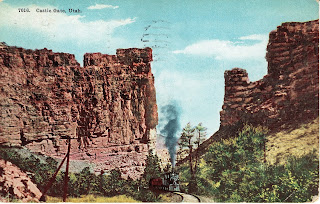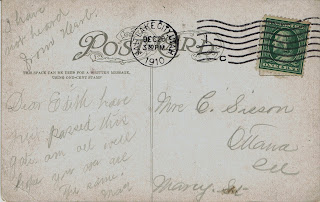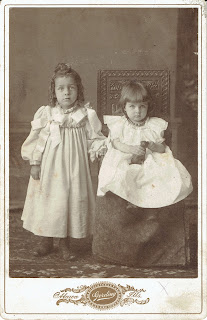Cordelia Francis Hammond was my 2nd great-grandmother. She died when I was 4 years old and I have no memory of her. I asked my great aunt Velma, Cordelia's granddaughter, to tell me about her grandma. Aunt Velma wrote the following and mailed it to me several years ago:
Cordia was daughter of Thomas & Martha Hawkins Hammonds. Cordelia Francis Hammond (nicknamed Cordia) was born March 5, 1877 - passed away June 7, 1970 she was 93 years old, plus three months & two days. She was married at Pouhatan, Arkansas to David Lincoln Nicholas. She later married Joseph Dye at West Plains, Mo. She was born in Howell County, Mo. Cordia & Joseph Dye lived at Koshkonong, Mo. 18 miles east of West Plains, Mo. on 63 Highway, she lived with my mother in Kansas City her last few years until she got where she couldn't take care of her. She died in a nursing home in Independence, Mo. a suburb of Kansas City, Mo. Cordia had one brother Willie Hammonds lived at Sturkie, Arkansas, one sister Gracie Lemmons of Phoenix, Arizona. 10 grandchildren, four step-grand kids, 28 great grandchildren, & 16 great great grandchildren.
Cordia and Joseph are buried in Koshknong, Mo. Cemetery. We go Decorate their graves every year. Cordia was a nurse during the war, she put a string of asfidity around her neck & never did get a disease. They lived close to Railroad Tracks in Koshkonong. I used to visit when I was a child, I would run hide every time a train came by. When she lived at my mothers she had to have peaches for supper every night. Grandpa Dye had a Service Station in Koshkonong. He was married before, then his wife died. Her picture is hanging in Bobs front room. Joseph Dye died in 1956. I don't know much about Grandpa Dye but he was a great man. We loved him.
Cordia Hammonds & Dave Nicholas got married but I don't know when. They had 4 daughters Belle, Hattie & Beulah. They had a small daughter to die, I didn't know her name.
Researching Cordelia, I found that most of what Velma wrote was accurate. I enjoyed the little extras, like the peaches for supper. Cordia was living with her daughter Hattie Cobb, who happened to grow and can the best peaches ever, so no wonder she wanted them each evening.
 |
| My favorite photo of Cordia. It's an undated postcard print. |
The first evidence I can find of Cordia is in the 1880 census. She was listed with her family in South Fork Township, Howell County, Missouri. The birthdates and birthplaces of the children tell us that the family came to Howell County between 1875 (a daughter's birth in Arkansas) and 1877 (Cordia's birth in Missouri).
The 1890 census records were destroyed in a fire, so that year isn't available to use for documenting the family. I do know that Thomas and Martha had additional children after 1880. Siblings Willie and Grace were listed in Cordia's obituary and I found records for children born as late as 1897.
I found Cordia's marriage record in 1893 to David Lincoln Nicholas. It's difficult to read, but interesting to note they were under the age of eighteen and their fathers both had to consent to the marriage. They are listed as living in Moody, Howell County, Missouri.
 |
| Ancestry.com, Missouri Marriage Records, 1805-2002, Image 259/280, accessed 14 Sep 2017. |
I haven't been able to locate Cordia and David in the 1900 census. I need to take some time and look through the images page by page because it's possible the name was hard to read and they were indexed incorrectly. I found them in 1910 on the census records living next door to Cordia's oldest brother John and his family in Washington, Fulton, Arkansas. It was here that their daughters were born.
- Nora Belle Nicholas was born on April 3, 1897 (married David Ward)
- Hattie Eugene Nicholas was born on June 3, 1899
- Beulah M. Nicholas was born on October 9, 1901 (married Walter Wallace)
- and that infant daughter Aunt Velma mentioned was born and died before 1910. She is sort of listed on this census. It asks how many children the mother has had (4) and how many are living (3).
The family was still in Washington, Fulton, Arkansas in 1920, though Hattie was the only child still at home. The two older daughters had married and started their own families. Daughter Beulah and her husband were living right next door. Hattie followed suit soon after, when she married Henry Clay "Kay" Cobb in 1921. Aunt Velma mentioned in her notes that Cordia was a nurse during the war. Because of her age, I assume World War I, though I really don't know. If that's the case, she may have been out of the house for some of the time right before this census. I had never heard of "asfidity" so I had to look it up. I found this
blog post that explains the folk remedy. Apparently people believed that wearing certain herbs would ward off the flu, polio, and other illnesses. The herbs were kept in a bag that was either pinned inside the clothes or worn on a string around the neck. So now we all know.
Sometime between 1920 and 1923, Cordia and David Nicholas were divorced. No one alive seems to know why. In 1923, Cordia married Joseph Dye, a widow seventeen years her senior. His first wife had died young and he had her portrait made for $300, so the story goes. Cordia wouldn't allow it to hang in their home, so he hung it in his office. Like my aunt Velma mentioned, the portrait now hangs in the living room at Bobby Cobb's home in central Missouri. I photographed it when I was there to visit in July. It has a big elaborate frame that I sadly didn't capture in my picture. $300 back then, in rural Missouri, was a bunch of cash to spend on a wall portrait. It's really spectacular. Uncle Bob said his Grandpa Dye wanted to be sure that the portrait was always taken care of and hung where it could be seen. Uncle Bob promised he would see to it. Even though she was not a blood relation, it's a sweet love story and a promise is a promise.
 |
| Portrait of Sarah Rainwater Dye, 1st wife of Joseph Dye, as it hangs in the home of Bobby Cobb. |
While at my Uncle Bob's this summer, he also brought out an envelope with a handwritten note documenting the marriage of Cordia and Joseph along with their marriage certificate. I just had my phone, which was almost dead, so I quickly snapped a photo of the note before it died completely (see below). Cordia and Joe lived in Koshkonong, Missouri, a little town along the highway. Velma said Joe owned a service station. Uncle Bob remembers that he had a business of some kind and that's where Sarah's portrait was kept. In 1930, on the census, they were recorded living on Luyster Street and he was a "buyer" of "ties". Railroad ties? I looked at a map and Luyster is a long street that intersects with Hwy 63. The railroad runs closest to the street on the highway end of Luyster. Aunt Velma remembers the scary trains, so their farm must of been in that area.
 |
"J. F. Dye and Corda F. Hammond was married April 25 (27 is written below 25) 1923"
Handwritten note possessed by Bobby Cobb, unknown by whom written. |
Cordia was widowed in 1944 when her husband Joseph Dye passed. She lived until 1970 and from what I understand was quite eccentric. My mom and her sister both recall going to visit at their great-grandma Cordia's home, but they weren't permitted in the house. They would wait on the front steps where they were allowed to eat grapes from the vines that grew there. Another vivid memory was the view inside her home from the front door. In her later years, Cordia became what we know now as a "hoarder". She didn't throw things away and from her front door all one could see was a narrow path down a hall. Things, papers and magazines and who knows what, were stacked along both walls. When my mom told me the story, she said it was a good thing that house never caught fire.
Later, when she was unable to care for herself, Cordia went to live with her daughter Hattie. Cordia was a quiet woman. In fact, my aunt doesn't remember ever hearing her great-grandmother speak. Sadly, she was just kind of in the background. Peaches, however, was something my aunt did remember. She thinks Cordia had a bowl of Hattie's peaches at every meal!
 |
5 generations - Cordia Dye, Hattie Cobb, LeRoy Cobb, Louise Cavanaugh & Shannon Cavanaugh (me).
Taken in Kansas City at Hattie's home in 1967. |
Cordia died in 1970 in Independence, Missouri. I think Aunt Velma may have copied some of the information she sent me from this funeral card as it matches up with her note (above), even the error in death year for Joseph Dye.
 |
| Obituary from the back of Cordia's funeral card. |
 |
| Cordia Dye's funeral card . |
Pallbearers at Cordia's funeral were grandsons J. D. Cobb, Bobby Cobb and Roy Cobb (Hattie's sons), Wayman Womack (husband of Hattie's daughter Velma), Jewell Ward (Belle's son), Gary Proffitt (husband of Belle's daughter Virginia), and T. J. Waters (husband of Beulah's daughter Imogene).
 |
The grave of Cordia, not Pauline, and Joseph Dye in Koshkonong Cemetery, Koshkonong, MO.
Photo taken July 2017. |
I know this is the grave of Cordia and Joseph Dye. The dates are her birth and death date. Joseph's dates are correct. It's the grave Aunt Velma decorated every year in Koshkonong. I haven't figured out for sure where the name Pauline comes from. I have an idea, though. I scribbled the name Cordia...
 |
| Cordia, scribbled, could maybe be mistaken for Pauline... |
...and I think I can see how maybe if the name was sloppily written it might have been mistaken for Pauline by the cemetery. I don't have a copy of Cordia's death certificate. It won't be available online until 2020 as Missouri makes digital copies available 50 years after death, so we can look at it then and see if my theory pans out!






































